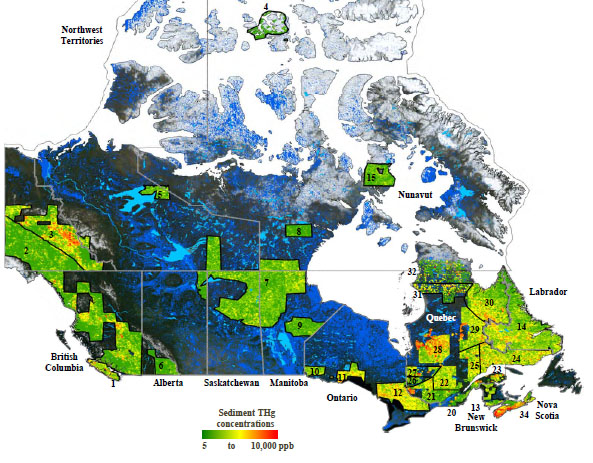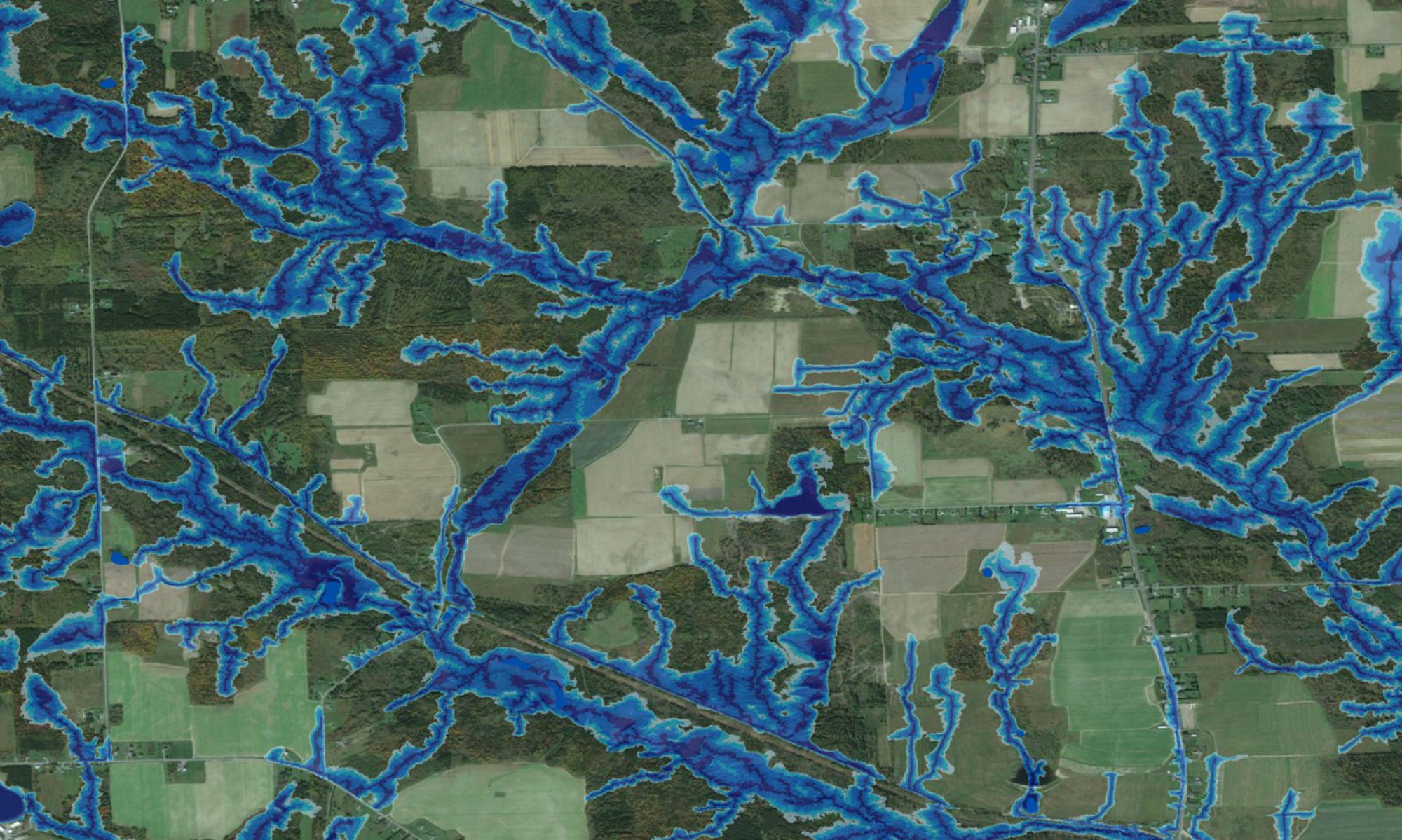
A key for understanding how mercury moves from the atmosphere into fish and wildlife is to know where Hg accumulates in the landscape. Basically, forest canopies are very effective scavengers of atmospheric Hg, whether Hg is in gaseous, water-dissolved, or particulate form. Hg, once captured at canopy level, is transferred to the forest floor, gradually and seasonally, through litter fall. Depending on local soil drainage, part of this Hg becomes methylated, and is rendered toxic through the trophic process of bio-accumulation. Some of the Hg stored in the forest floor is recycled through vegetative uptake, with mycelial Hg ubtake and subsequent transfer to fungal fruiting bodies (mushrooms) providing a pathway for terrestrial Hg bio-accumulation. As water percolates over and through watershed substrates, some of the accumulated and methylated Hg is carried towards the streams in association with particulate matter (mineral and organic sediments) and tea-coloured dissolved organic matter (DOM): the darker and the more cloudy the water, the more Hg is available for trophic uptake in fresh waters. Basically, DOM and Hg concentrations increase in proportion with increasing wet-area coverage above each stream location, and this can be mapped, systematically.

This web site will soon display details of the Hg modelling and mapping process at the forest stand level, and how the process is applied to discerning Hg concentration patterns according to the open stream and lake sediment files compiled by the Geological Survey of Canada. The image on the left shows a selection of the Geological Survey of Canada open-file data for Hg in lake and stream sediments overlaid on a satellite image for Canada, also containing a blue shaded upland/lowland delineation.
Presentation
- M. Nasr, T.C. Clair, P.A. Arp. 2011. Quantifying spatial and temporal transfer of mercury from upland to lowland in forested watershed of Kejimkujik National Park, NS.
Posters
- P.A. Arp, M. Nasr, J. Ogilvie, J.P. Arp, A. Rencz, H. Morrison. Geological controls concerning mercury accumulations in stream and lake sediments across Canada.
- J.S. Bhatti, M. Nasr, P.A. Arp, J. Noseworthy. Accumulation of atmospheric mercury in forest canopies.
- M. Nasr, P.A. Arp, A. Rencz. Mercury variations in stream and lake sediments of Nova Scotia, Canada.
- M. Nasr, J.S. Bhatti, P.A. Arp. Mercury variations in soil layers in relation to total Carbon, Nitrogen and Sulphur contents.
Publications
- N. Mina, J. Ogilvie, M. Castonguay, A. Rencz, P.A. Arp. . Total Hg concentrations in stream and lake sediments: Discerning geospatial patterns and controls across Canada. Applied Geochemistry. 2011. Volume 26, Issue 11, Pages 1818-1831.
- N. Mina, P.A. Arp. Hg concentrations and accumulations in fungal fruiting bodies, as influenced by forest soil substrates and moss carpets. Applied Geochemistry. 2011.Volume 26, Issue 11, Pages 1905-1917.
- C.D. Ritchie, W. Richards, P.A. Arp. Mercury in fog on the Bay of Fundy (Canada).Atmospheric Environment. 2006. Volume 40, Issue 33, Pages 6321-6328.
- M. Nasr, C.D. Ritchie, P.A. Arp.. Atmospheric Hg deposition and terrestrial Hg pathways in coastal catchments of the Bay of Fundy, Canada. ICHMET XIII International Conference on Heavy Metals in the Environment, Ed. Trindade R. B.E., Melamed, R., Sobral, L. G. S., Barbosa, J., P., B. Rio de Janeiro, Brazil. 2005. Page 268.
- M. Lucotte, R. Canuel, S. Boucher de Grosboi, M. Amyot, R. Anderson, P.A. Arp, L. Atikesse, J. Carreaul, L. Chan, S. Garceaul, D. Mergler, R. Ritchie, M.J. Robertson, C. Vanier. An Ecosystem Approach to Describe the Hg Issue in Canada: from Hg Sources to Human Health. In: Dynamics of Mercury Pollution on Regional and Global Scales N. Pirrone, K. R. Mahaffey (eds.). 2005. Chapter 19.
- T.A. Clair, P.A. Arp, C.E. Gabriel, C. Staicer, G.L. Brun, J. Holmes, D.R.S. Lean. Surface water mercury budgetsfrom a clear and a brown-water lake in Kejimkujik NationalPark.Society of Environmental Toxicology and Chemistry (SETAC). 2005. Pages 251-263.
- T.D. Jardine, T.A. Al, K.T.B. MacQuarrie, C.D. Ritchie, P.A. Arp, A. Maprani, R.A. Cunjak.Water striders (family Gerridae): mercury sentinels in small freshwater ecosystems.Environmental Pollution. 2005. Volume 134, Issue 1, Pages 165-171.
- M. Legrand, P.A. Arp, C. Ritchie, H.M. Chan. Mercury exposure in two coastal communities of the Bay of Fundy, Canada. Environmental Research. 2005. Volume 98, Pages 14-21.
- F-R. Meng, P.A. Arp, A. Sangster, G.L. Brun, A. Rencz, G. Hall, J. Holmes, D. Lean, T.A. Clair. Predicting total methyl mercury and dissolved organic carbon in Nova Scotia freshwaters using a GIS approach. Submitted to Environmental Toxicology and Chemistry. 2003.
Thesis Work
- Mina Nasr. 2007. Mercury levels in fungal fruiting bodies from interior and coastal forests in the Bay of Fundy region, New Brunswick, Canada
- Laura Sweeney. 2007. Mercury cycling through finfish aquaculture within the lower Bay of Fundy: possibilities for control in support of the health of coastal communities
- Catherine Irene Otorowski. 2007. Mercury in gulls of the Bay of Fundy

